Wisdom teeth, also known as third molars, are the last teeth to erupt into the mouth, generally between the ages of 16-20. Problems with infected or impacted wisdom teeth usually cause dull pain that is felt in the back of the mouth or jaws and sometimes up into the ear or down into the neck. These infections are not only uncomfortable, but can damage adjacent teeth.
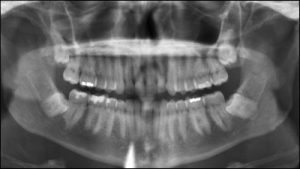

Impacted wisdom teeth impinging on neighboring teeth, painful infection and cheek biting around an erupting wisdom tooth.
Problems Caused by Wisdom Teeth
Wisdom teeth problems are very common. For most people, the jaw bone is actually not big enough to fit all 32 permanent teeth. Since wisdom teeth are the last to develop, they are often crowded out of their proper eruption position or blocked by the overlying bone or gums. When a tooth fails to erupt properly, it is said to be impacted.

Impacted wisdom teeth.
When the wisdom teeth begin to erupt, usually in the late teens or early 20s, a recurrent cycle of infection of the gums can occur. This causes pain around the tooth, which sometimes spreads to the neck or side of the face.
(a)  (b)
(b) 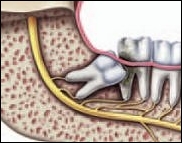 (c)
(c) 
Complications such as infection (fig. a) , damage to adjacent teeth (fig. b) and the formation of cysts (fig. c) may arise from impacted teeth.
If left in place, impacted wisdom teeth can cause chronic infections that damage adjacent teeth or cause severe recession of the gums and bone. If a wisdom tooth erupts with no opposing tooth, it may cause accidental cheek biting or may hyper-erupt, causing disruption of the occlusion or bite of the other teeth. More serious problems occur if the tissue surrounding an impacted tooth enlarges to form a cyst or tumor.
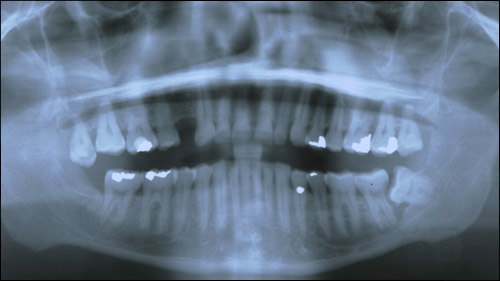

Left: An impacted wisdom tooth has caused the loss of the adjacent tooth, and hyper-eruption of an upper wisdom tooth. Right: A cyst surrounding an impacted wisdom tooth.
Wisdom teeth are also associated with crowding of lower incisor teeth in late teens and early twenties. If left long enough, it may require orthodontic retreatment.
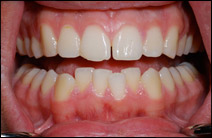
Lower incisor crowding associated with impacted wisdom teeth.
Scientific studies show that wisdom teeth that do erupt are as prone to disease as those that remain impacted. Oral hygiene is difficult in the far reaches of the mouth, and wisdom teeth are often quickly attacked by the bacteria that cause decay or gum infection. If they were not taken out during the teen years, a high proportion of wisdom teeth will eventually need to be removed in later years.
When Should Wisdom Teeth be Removed?
The ideal time for removal is at about age 16. When the roots of the teeth are still immature, surgical removal is rather simple and a young person is capable of optimal healing. Wisdom teeth can be removed as early as age 11-12.
Wisdom Teeth Development
Extraction after the teen years is frequently needed, but always results in a more difficult recuperation and higher complication rates.
Not all wisdom teeth problems are painful or visible, and there is risk to a “wait and see” approach to teeth that don’t hurt yet. As wisdom teeth grow their roots become longer, the bone becomes dense, and the teeth are more difficult to remove. Waiting until adult years results in a prolonged recovery and a higher chance of infection, sinus problems, or nerve injury in the jaw. Delayed treatment may also cause irreversible damage to the adjacent teeth.
It is best to have wisdom teeth evaluated at about age 16, even if there are no symptoms. With and exam and x-rays of the jaws, it is possible to determine if they should be removed. If you are older and encounter wisdom teeth trouble, then an immediate examination is best.
Wisdom Teeth Extraction Procedure
The surgery to remove wisdom teeth is done in our office surgery center with the aid of intravenous sedation anesthesia. We start by placing sensors to monitor your vital signs; then we start an intravenous line and supplemental oxygen. It only takes about 30 seconds for the medication to work, and we won’t begin your procedure until you are comfortably asleep.
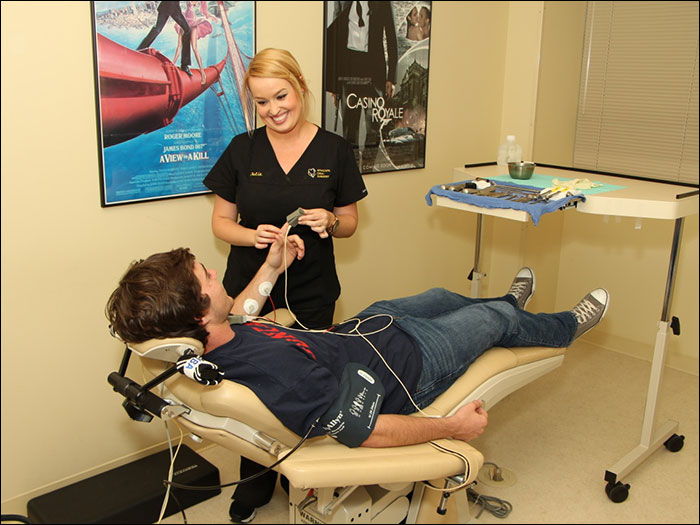
Some teeth are already exposed and more easily removed. For those that are impacted, an opening is made into the gum tissue and a small amount of surrounding bone is removed. The tooth can then be carefully removed. Sometimes dissolving sutures (stitches) are needed to close the wound. It takes about 30-45 minutes for the actual procedure.
When you have finished your treatment, you will awaken from the sedation rather quickly (It feels like only 3-4 seconds have elapsed). You will be comfortable since the area will be numb from the local anesthetic. Once you are stable and recuperating well you can return home, where you should keep your activity light for several days.
We will make sure you are comfortable during your recuperation. Most patients require prescription pain medication. There is often some swelling and stiffness of the jaw, and a soft diet for several days is advised. You can advance your diet to more normal foods after a few days as long as your comfort permits.
Click here for more complete pre-operative instructions.
Click here for more complete post-operative instructions.
Click here to learn more about the risks and potential complications of oral surgery